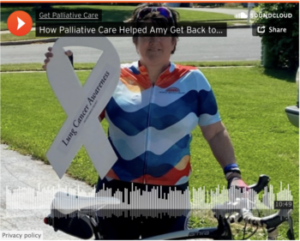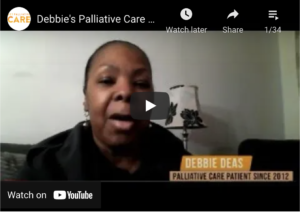How Palliative Care Helped Amy Get Back to Her Hobbies
 Amy is in her mid-40s and loves the outdoors—especially biking, hiking, and walking her dog.
Amy is in her mid-40s and loves the outdoors—especially biking, hiking, and walking her dog.
In the fall of 2018, she felt a lump on her neck, and when it did not go away, she visited her primary care doctor. After many tests, she was diagnosed with Stage 4 lung cancer that had spread to her lymph nodes and femur (thigh bone). She was devastated and scared.
A few weeks later, Amy started treatment with radiation and a medicine that helps the body’s immune system fight cancer. This combination can get cancer under control but may cause side effects.
After a month of treatment, Amy’s oncologist, or cancer doctor, recognized that she could use an extra layer of support to deal with her symptoms and stress. A palliative care nurse started to visit her at home every week and was available by phone whenever Amy needed to reach out. She helped Amy through her difficult treatments, both physically and emotionally. The goal was to get her back to feeling like herself again, which to her, meant being active and riding her bike.
This is Amy’s palliative care story.
Managing Side Effects
Before Amy’s first palliative care visit, she was having a hard time with the side effects of treatment, including being in a lot of pain and having trouble eating.
“I had pretty bad diarrhea, vomiting, and could not eat at all. The only thing I could really eat was a popsicle and yogurt here and there. I was losing a ton of weight, pretty much ten pounds per month. I couldn’t walk, and could barely get anywhere without help.”
Having palliative care to support her made a big difference in her ability to continue with her treatment. She worked closely with her nurse, who was helping to manage her side effects, which included making sure she took medication at the right time. Palliative care also helped her manage anxiety and depression, and made communication with all of her doctors easier.
With the help of palliative care, Amy was able to continue treatment and start doing things that matter to her.
“With the help of palliative care, I was able to get back to riding my bike. And as of today, I am able to ride my bike at least ten miles per week. I’m able to hike. I’m able to walk my dog again, and I’m actually thinking about going back to work, and that will make a huge difference.”
To learn more about palliative care and how it can help you or someone you love who is living with cancer or another serious illness, call us at 973-888-9100.
Source: www.GetPalliativeCare.org.
How Palliative Care has helped Debbie who lives with Multiple Myeloma
Debbie is a hairdresser, a business owner, and a proud mother and grandmother. She has been living with multiple myeloma (a type of blood cancer) for over 10 years. After she was diagnosed in 2012, she was asked if she wanted the support of a palliative care team. Since then, Debbie’s palliative care team has helped her manage pain and symptoms to improve her quality of life and help her stay active, whether walking, working, or dancing in her living room.
She recently shared, “Palliative care has been magnificent as far as I’m concerned. Like I said, they put me back in the driver’s seat.”
Source: www.GetPalliativeCare.org.

